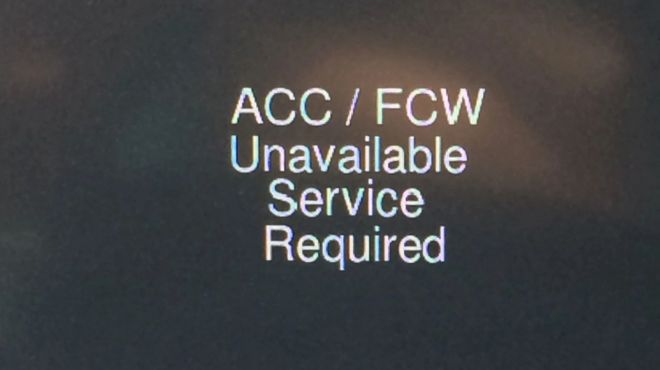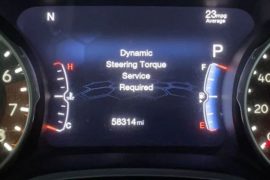The “ACC/FCW Unavailable Service Required” message appears on your screen for a variety of reasons. Most commonly, a loose connection, dirty sensor, sensor alignment issue, obscured bumper, incompatible grille installation or too much reflected light tricks the car’s computer into temporarily disabling the Advanced Driver Assistance systems for safety.

The goal of this blog is to plainly explain what’s behind that cryptic ACC/FCW notification so you don’t feel lost. I’ll overview how features like Adaptive Cruise Control and Forward Collision Warning are supposed to function. Then we’ll get into the likely culprits of why that disruptive message appeared and how to get your vehicle’s protections rebooted.
What is the ACC and FCW System?
Before diving into reasons why your car’s ACC and FCW systems may suddenly become unavailable, it helps to understand what they normally do for you.
ACC stands for Adaptive Cruise Control. Essentially this function helps automatically adjust your cruising speed based on traffic flow. For example, if you set your cruise control to 60mph but start gaining on slower vehicles ahead, ACC will slow your car down to match their speed while maintaining a preset following distance. Once the path clears again, it smoothly accelerates you right back to 60mph. Pretty nifty dynamic speed adaptation without you needing to constantly tap the brakes or reset traditional cruise!
Meanwhile, FCW means Forward Collision Warning. This system uses radar, cameras and sensors to continually scan for slowed or stopped vehicles directly in your projected path ahead. If it detects you rapidly approaching an obstruction and determines an impact is likely based on your speed, FCW reacts by flashing visual alerts on your instrument panel and sounding audible alarms. It’s meant to prompt you to take immediate action and apply the brakes.
So in a nutshell: ACC automatically adapts your driving speed for you within reason, while FCW urgently warns that you may need to suddenly brake based on impending obstructions it identifies. Both extremely helpful driver assistance technologies – when operating normally.
Now let’s review why you might suddenly get that jarring message that service is required…
Also Read – ACC FCW Limited Functionality: How To Fix The Warning?
Causes and Fixes for the “ACC/FCW Unavailable Service Required” Warning
So your car’s high-tech safety features seem to have abruptly stopped working, resulting in the “ACC/FCW Unavailable Service Required” alert appearing. There are a variety of possible culprits for what triggered this disruption. Let’s review some of the most common causes:
Dirty Front Radar Sensor
One straightforward explanation could be simple road grime interfering with the front radar sensor. This small device is located behind the front grille or bumper. It has to remain clean and unobstructed in order to accurately detect slowing and stopped cars at range.
Over time, normal traffic spray can gradually cake on dirt, sap, splattered insects and other gunk which eventually blocks the radar signals. When blocked, it cannot reliably read traffic ahead and so ACC and FCW go offline to prevent potentially unsafe operation.
The good news is this an easy fix – safely clean the sensor! Using soft rags and automotive cleaning products, gently wipe down the sensor surface taking care not to apply pressure or scratch the components. Be extremely cautious using compressed air, pressure washing or any cleaning methods that could damage the precision instrument. With the radar freshly decluttered, ACC/FCW should reboot.
Driving in Bad Weather
Sometimes heavy rain, snow or dense fog can also temporarily interrupt ACC/FCW operation. Extreme weather can effectively blind the front radar sensor obscuring its view of the road ahead similar to dirt buildup. Additionally, heavy precipitation can interfere with the sensor’s radio-wave signals even without direct obstruction.
In these cases, your car is smart enough to know its visual/detection capabilities are impaired so it prudently suspends certain driver assistance features to avoid potentially missing slowed traffic ahead. Not much you can do but wait it out. Once the storm passes and sensors re-acclimate, ACC and FCW will come back online. Just drive cautiously in the meantime and don’t fully depend on those systems in poor visibility.
Broken Sensor
If you’ve ruled out simple dirt or bad weather as the trigger, its possible the front radar sensor itself has mechanically failed. These safety components can occasionally get knocked out of position or take damage over years of normal wear and tear. Maybe an object or debris struck the sensor, or vibration from rough roads gradually loosened its precise alignment.
In any case, if the onboard diagnostics detects component failure in the sensor, it will disable ACC/FCW as they require accurate radar data to safely function. Unfortunately the only remedy is to replace the damaged sensor outright. This will likely require a trip to the dealership or qualified repair shop. They’ll need to diagnose which sensor specifically needs replacement, source the correct replacement part, remove and properly reinstall it.
While not a simple fix, sensor replacement is necessary in cases of hardware malfunction to get ACC and FCW operational again. Expect a decent labor charge for all the calibration required too. The cost is worth it however for restoring these vital active safety systems.
Sensors Confused by Reflected Signals
Sometimes the radar sensor can get confused rather than outright damaged. Certain environments like tunnels or bridges can create strong radar signal reflections that essentially overstimulate the sensor with too much perceptual data to process. Imagine someone shouting while you’re trying to concentrate – you can’t think straight!
This sensory overload causes the ACC and FCW logic to disengage since its view is temporarily blocked by an echo of radar noise. As soon as you’re past the reflective area, the systems will reboot normally. To avoid issues, be alert for tunnels and bridges which often use materials and curvature that bounce sensor energy back at itself.
Unsuitable Aftermarket Grilles
Many truck and SUV owners like to customize their ride with fancy chrome aftermarket grilles without realizing it can sabotage the radar sensor’s field of view. If an aftermarket grille blocks a substantial part of the sensor behind it, that can entirely obscure oncoming vehicles and objects.
Unable to “see”, ACC and FCW will rightly disable to prevent the grille blind spot from causing a crash. The fix is simple – replace the stylish aftermarket grille with a boring OEM factory one. Bland is better to restore full sensor functionality. Alternatively, there are some aftermarket grilles engineered specifically to work fine. But many cheaper ones will likely keep causing this issue.
Computer Malfunction
All those fancy driver assistance features rely on intricate software and programming. Like any computer, the system can experience frozen programs, corrupted files or just get overwhelmed with tasks. Any software crashes or malfunctions will switch ACC and FCW status to unavailable or offline until the computer can be revived.
If turning the vehicle power off and back on again doesn’t clear the issue, the fix lies in more robust rebooting: allow the technicians at a qualified shop to fully diagnose and resolve the computer bugs causing the malfunction. They can access tools and system resets not available to drivers to essentially restore your car’s brain. This may entail software updates and reinstallation so be prepared for a labor fee. But ultimately healthy computers are what make ACC and FCW tick optimally.
Loose Sensor Connections
Modern cars involve a web of sensitive wiring and interconnects that can vibrate loose over time, especially on bumpy roads. The front radar sensor relies on a solid connection to the car’s central computer in order communicate the traffic data is gathers. Loose, corroded or vibrating wires in that linkage can cause signal degradation or dropouts.
If connection problems reach the point of intermittent failure, it will trigger the ACC/FCW shutdown to avoid inaccurate readings. Technicians can thoroughly inspect sensor-related wiring for chafed, loose or corroded connectors and pins. Any degraded connections get replaced or tightened up to restore uninterrupted data flow between sensor and brain.
Electrical Issues
With such a complex electrical network powering all these sophisticated systems, vehicles often develop short circuits, blown fuses, voltage drops or grounding problems over their lifetime. Any flaws that affect the sensor or computer can lead to ACC/FCW going offline. Diagnosing the source of gremlins usually requires wiring diagram schematics and chasing electrical issues is labor-intensive. But until everything checks out, these systems may glitch even after reboot attempts. Restoring sound electrical operation re-enables the disrupted safety functions.
Connectivity Issues
The modern connected car can sometimes trip over its own tech-savvy nature. Features like ACC and FCW integrate closely with your infotainment system which manages things like Bluetooth pairing and other wireless connections. Too many devices drawing data at once can overload the car’s processors – or create signal interference.
If you notice the ACC/FCW offline warning popped up right after syncing a new phone, adding streaming audio or inserting a WiFi hotspot – bingo. The fix is easiest using process of elimination. Start removing recently added devices one by one to identify the connectivity source overtaxing systems. Sometimes even an underpowered USB charging cable can weirdly drag down sensors. Finding the problematic device and disconnecting it often swiftly restores full self-driving suite functionality.
Software Glitches
We expect our vehicle to operate reliably as an appliance – just turn the key and drive. But late-model cars now rely on millions of lines of code directing incredibly complex logic modules controlling vehicle dynamics, performance, efficiency and safety systems. Imperfect software inevitably has bugs that lead to freeze-ups, laggy operation or inconsistent detecting/braking.
Although ultra annoying when a software hiccup disables ACC or FCW mid-drive, technicians can often quickly roll back and reinstall code updates to resolve most common glitches remotely. So if a recent service visit preceded the system weirdness, chances are a basic software reset will reboot normal functionality. Updates also continuously improve performance of vehicle safety tech as algorithms evolve.
Transmission Issues
Yup, even your transmission can trigger ACC/FCW failure in certain cases. Sensors constantly monitor acceleration forces to determine appropriate adaptive cruise speeds and safe following distances. If automatic transmission fluid becomes contaminated or low, or sensors detect slipping gears or shifts outside normal parameters, your vehicle realizes its speed detection could be compromised.
Rather than continue monitoring traffic with a faulty transmission sensor, the failsafe decision disengages ACC/FCW. Technicians can scan for any diagnostic trouble codes pointing to transmission issues then change fluid, adjust bands, tighten connections or replace worn parts as needed until drivetrain operation shows normal again. Then ACC and FCW logic reconnects.
PCM Issues
The Powertrain Control Module (PCM) acts as mission control for most engine, transmission and emissions management functions. It also plays a role in directing ACC adaptive speed adjustments and FCW collision alerts. Like any electronics, the PCM can fail over time or get damaged from voltage spikes.
If the troubleshooting points to a chronically faulty PCM based on other symptoms happening concurrently, the prudent call is fully examining and likely replacing the PCM. Technicians will diagnose if replacement is necessary and whether programming/coding of the new module needs adjusting during installation to avoid the same premature failure. Expect an hour+ labor bill for the PCM swap.
Misaligned Sensor
Even a radar sensor in perfect health won’t operate accurately if knocked out of position. Forward collisions, minor fender benders, curious kids throwing rocks, or even mud trapped behind the grille can subtly shift sensor alignment over months of driving. If knocked askew even a few degrees off center, the radar beams spread inaccurately and detection range suffers.
Unfortunately there is no DIY fix beyond removing external obstruction or adjusting aftermarket accessories blocking the sensor. Proper realignment requires a trip to the dealer or shop with special aiming tools and calibration software to precisely verify and digitally dial-in the radar’s position. But accurately rehoming the sensor restores ACC and FCW functionality by re-establishing the correct radar picture.
Battery Problems
Vehicle batteries naturally weaken over time. Cold weather and additional electrical accessories can also tax the battery beyond its charging capacity. If voltage drops too low, various unpredictable systems can malfunction or turn off entirely, including ACC and FCW.
Before expensive repairs, it’s worth load testing the battery to determine if merely a replacement is required. Technicians can rule out battery failure first before further troubleshooting. Installing a new battery with higher cranking amps and reserve capacity may be all that’s needed to stabilize power delivery and reboot disabled safety systems.
Windshield Issues
A properly aligned windshield is vital for allowing the radar sensor behind it to have a consistent view of the road ahead. Tiny chips and cracks can refract the sensor’s beams enough to create detection problems. Furthermore, many ACC/FCW-equipped cars require special acoustic windshield glass that dampens interference with the radar waves.
If the troubleshooting confirms windshield issues are scattering the sensor signal and garbling data, then adjustment or replacement of the windshield may be the simplest fix. Technicians can rule out alignment or reflective issues first, then perform windshield repair or replacement if that is determined to restore normal sensor operation.
DTCM Problems
Behind the scenes, the Drivetrain Control Module (DTCM) directs transmission shifting, torque delivery and vehicle stability regulation – all crucial data points for ACC and FCW logic. If the DTCM itself sustains damage or starts commanding erratic operation, it endangers the chain of effective vehicle control.
So the onboard systems may prudently disable ACC/FCW functions rather than operate on corrupted DTCM data. Technicians typically recommend DTCM replacement in cases of confirmed failure since it is difficult to fully repair or reprogram them. While not a cheap fix, a new properly-coded DTCM can often resolve multiple issues in one swap.
Prevention Tips
While no car system lasts forever, you can help prolong ACC/FCW operation through smart prevention:
- Regular sensor cleaning – Occasionally wipe down the small radar sensor behind the grille to prevent dirt/debris buildup.
- Care when installing grilles – Choose grill replacements guaranteed to not block the sensor field of view.
- Avoid accessories blocking sensor – Keep the front emblem clear of plate frames, camera mounts etc.
- Check battery and transmission – Have battery, fluids and belts inspected based on maintenance schedule to help systems run optimally.
Conclusion
Hopefully this breakdown demystifies the ominous “ACC/FCW Unavailable Service Required” warning that can suddenly appear and disable vital active safety systems. While the message sounds quite serious on the surface, in many cases the underlying issues can be easily resolved or at least better understood.
We covered how ACC and FCW systems normally function when operating correctly, using radar and cameras to adapt speeds and visually alert drivers. Then we explored an array of potential issues that could spur the dreaded warning message – from simple dirt on the sensor to severe electrical and computer faults. For each culprit, typical fixes were explained.
While advanced driver assistance technology aims to improve safety, it must remain fully functional through adequate troubleshooting and maintenance. Some remedies involve simple cleaning or software resets, while other solutions require more extensive sensor and electrical repairs.
But now that you know the scope of what potentially interrupts ACC and FCW, you can better convey specific symptoms to your dealership technician. This will help them accurately diagnose issues faster. Catching problems early maximizes convenience of repairs before small glitches cascade into disabling failures.
Stay vigilant to restore these supplemental safety systems soon as problems arise. Identifying the specific cause of ACC/FCW disabling also reduces guesswork and costs to pinpoint the remedy. With deeper understanding, the warning light becomes less mysterious and soon your vehicle will be back to smoothly assisting your driving.



